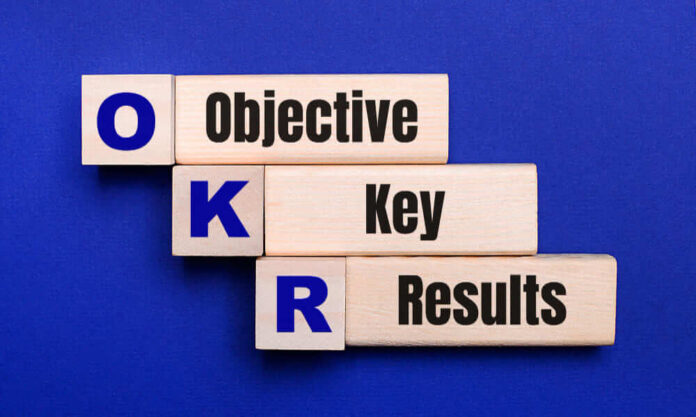The use of objectives and key results (OKRs) has gained popularity in the business world. Many companies are embracing OKRs as a management approach to set goals, monitor progress, and improve performance.
So, in this post, we will take a closer look at this innovative approach, exploring its unique components. We will also discuss the formula that drives the effectiveness of OKRs.
Components of OKRs
Objective: Setting Purpose-driven Goals
At the heart of every OKR (Objective and Key Result) lies an objective – a measurable goal that offers focus and direction. Objectives encapsulate what a company or team aims to achieve within a set timeframe. They are typically ambitious, inspiring, and aligned with the overall OKR template objectives.
Key Result: Measuring Success through Outcomes
Key results are established to measure progress towards an objective. These key results outline outcomes that must be accomplished in order to reach the objective. They should be measurable, attainable, and challenging metrics that indicate success.
Actionable Steps: Breaking it Down into Tasks
Once objectives and key results are defined, it is crucial to break them down into actionable steps – making them more manageable to tackle. These guidelines outline the steps that teams or individuals can follow to achieve their results and contribute to progress towards the objective.
The Recipe for OKRs
#1: Setting Challenging Goals
Effective OKRs establish challenging goals or ambitious targets. These objectives encourage individuals or teams to strive for accomplishments instead of settling for mediocrity.
By pushing boundaries, these stretch goals inspire innovation and lead to groundbreaking achievements that positively impact business success.
#2: Aligning with Company Culture & Strategy
To maximize effectiveness, it’s crucial that OKRs align seamlessly with the company’s culture and overarching goals. When crafting your OKRs, carefully evaluate how they contribute to your organization’s values and long-term vision.
This alignment not only fosters unity among employees but also ensures that everyone is working collaboratively towards shared objectives.
Utilizing an OKR template can be instrumental in structuring and implementing these objectives in a manner that resonates with your company’s ethos and overarching mission.
#3: Connecting Objectives with Key Results
The secret ingredient for the implementation of OKRs lies in the connection between objectives and key results.
Each key result should be directly linked to its objective, clearly demonstrating how achieving the result contributes to accomplishing the goal. This linkage enables efforts and efficient progress tracking.
#4: Ensuring Measurability and Objectivity
To make OKRs truly effective, they must be measurable and objective. Every key result should have a metric that allows teams or individuals to track their progress.
The ability to measure progress objectively is an advantage of using OKRs. It eliminates the influence of opinions, allowing for an accurate assessment of whether goals have been achieved or not.
#5: Reviewing Progress Regularly
Reviewing progress is an aspect of implementing OKRs. It is recommended to schedule check-ins and evaluations, whether on a monthly or quarterly basis. These reviews promote transparency by providing insights into any challenges faced and allowing for adjustments if needed.
6: Embracing Transparency & Accountability
Without any doubt, you will need both transparency and accountability for OKR implementation. Leaders and managers should create an environment where employees feel comfortable openly sharing their results, celebrating successes, and learning from failures.
Being accountable for assigned OKRs fosters a sense of ownership, collaboration, and personal growth. This way, trust is built in any business or organization.
#7: Encouraging Responsibility and Ownership
OKRs prioritize accountability and ownership. When employees have defined objectives tied to results, they feel more responsible for their work. This sense of ownership fosters commitment and engagement and ultimately leads to outcomes.
#8: Promoting Collaboration Across Teams
Collaboration can sometimes be a challenge within organizations when different departments or teams need to work together.
OKRs provide a language and framework that enable collaboration towards shared goals. By aligning objectives across units, companies can break down barriers, encourage functional teamwork, and drive overall organizational growth.
#9: Enhancing Clarity and Transparency
Implementing OKRs brings clarity at all levels of an organization. Clear objectives ensure that everyone understands what needs to be accomplished and why it is significant. Key results provide metrics that track progress toward those objectives.
This level of transparency reduces ambiguity, boosts morale by providing a sense of purpose, and allows employees to see how their contributions impact the organization’s success.
#10: Facilitating Agile Adaptation
OKRs play a crucial role in supporting agility by encouraging regular check-ins and reviews. These ongoing evaluations offer opportunities to make adjustments as needed.
If there are any changes in priorities or strategies due to factors such as emerging trends, customer feedback, or unforeseen challenges during the cycle, OKRs can be adapted accordingly, allowing for a responsive approach to market conditions and ensuring that organizational goals stay aligned with evolving circumstances.
#11: Creating a Culture of Continuous Improvement
OKRs help foster a culture of learning and improvement. By setting objectives, companies inspire their employees to push beyond their perceived limits.
Even if they don’t achieve 100% of their goals, the progress made towards these stretch targets drives growth and improves performance over time. This focus on improvement contributes to the development of engaged and motivated teams.
Final Note
In today’s dynamic business environment, organizations require tools for setting goals, aligning efforts, and driving success.
OKRs provide a proven methodology for achieving these desired outcomes. Companies can unlock their potential and propel themselves toward sustainable growth by adopting OKRs and following the discussed components and formula for success.
















